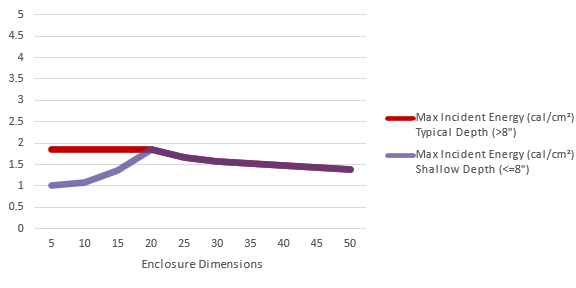Arc-Flash Settings & Sensitivity (IEEE Std 1584-2018)
When calculating arc-flash for a piece of distribution equipment, there are numerous settings you can adjust to change the resulting arcing current and incident energy values:
- The electrode configuration as described in IEEE Std 1584-2018 Table 9
- The dimensions of the enclosure
- The size of the gap between conductors
- The working distance
- The arcing time
The size of the change in the arcing current and incident energy differs for each setting. The charts below illustrate the sensitivity of each setting.
Arcing current is not shown for settings that do not affect it.
The data is based upon a 480V panel with a bolted fault current of 100,000 A and the default known settings.
Electrode Configuration
The electrode configuration has some impact on the arcing current and incident energy.
If the enclosure type is the same, a vertical configuration will have lower values than a horizontal configuration. Also, enclosed electrodes will have higher values than electrodes in the open air.
Enclosure Dimensions
The chart below shows the results for square enclosures from 5"x5" to 50"x50" with depths greater than 8" and depths less than/equal to 8".
In most cases, the dimensions of the enclosure do not significantly impact the incident energy.
As the enclosure size increases past 20" square, the incident energy steadily decreases. The incident energy does not change if the size decreases under 20" square unless the depth also decreases to 8" or less; a shallow enclosure less than 20" square will have roughly half the incident energy of a deeper enclosure.

Gap Between Conductors
Incident energy will increase and arcing current will decrease as the gap increases, but the difference is not significant.
Working Distance
Working distance is the second most significant factor when calculating arc-flash. As the working distance increases, incident energy decreases exponentially.
Arcing Time
Arcing time is by far the most significant factor when calculating arc-flash.
As the arcing time increases, incident energy also increases linearly. If the arc lasts for 2 seconds, the incident energy is 120 times what it is at one cycle (0.0167).